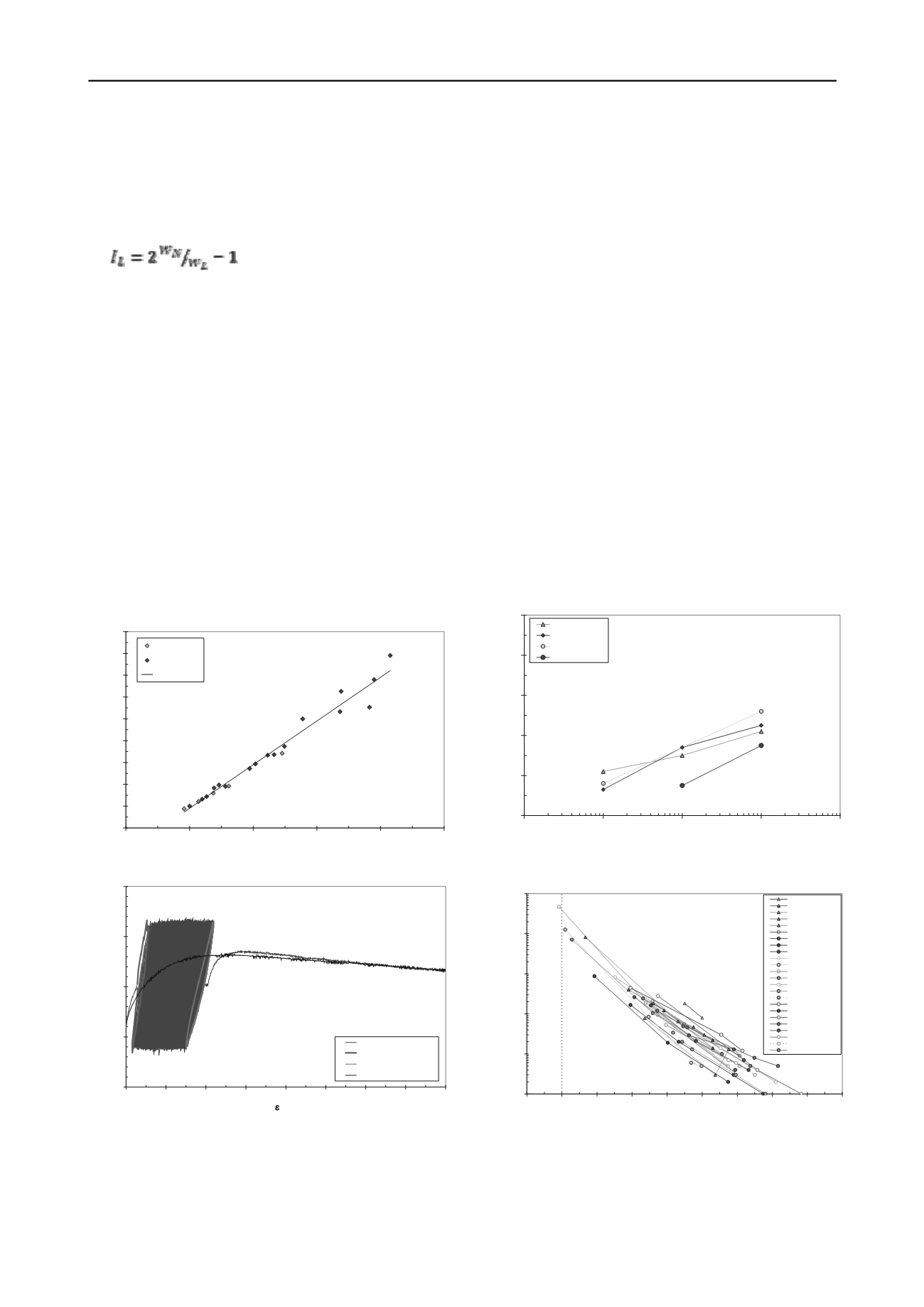
1413
Technical Committee 203 /
Comité technique 203
Swedish clays and similar soils. In Swedish practice, the plastic
limit of the soil is seldom determined and empirical relations are
usually linked to the liquid limit instead of plasticity index.
Correspondingly, the liquidity index of the soil is usually
replaced by a quasi liquidity index
w
N
/
w
L
. For the Swedish soils
in this investigation, which all had water contents higher or
equal to the liquid limit, a relation between the indices of
(1)
showed a high correlation, Fig.1.
The remoulded shear strength was found to be directly
related to the liquidity indicies. The sensitivity is the relation
between undrained and remoulded shear strength and for a good
correlation with a liquidity index, the value of the undrained
shear strength should also be considered.
The triaxial tests showed that cyclic loads or imposed
deformations that do not cause strains larger than the failure
strains at static loading do not cause any significant reduction in
undrained shear strength, Fig. 2. This is in agreement with
earlier observations by e.g. Andersen (2009). The failure strain
at static loading, and thereby the “safe” limit, is related to the
soil plasticity and the organic content and increases with these
parameters.
Rate effects entail that a limited number of cyclic loads can
bring shear stresses higher than the static failure load without
leading to failure. The size of the rate effects depends on the
frequency (or duration) of the cyclic load and the soil
properties. The frequency of wave and wind-loads is normally
assumed to be about 0.1 Hz, which brings fairly long durations
of the loads and moderate rate effects. Traffic and other cyclic
Mellösa 5m
Munkedal 10m
1
10
100
1000
10000
100000
0,9
1
1,1
1,2
1,3
1,4
1,5
1,6
1,7
1,8
t
max-cycl
/c
u
Number of cycles to failure
Mellösa 5m
Mellösa 8,5m
Norrköping 5m
Linköping 5m
Strängnäs 5,8m
Torpa 3,5m
Torpa 5,5m
Torpa 8m
Fråstad 6,5m
Onsjö 3,6m
Onsjö 7m
Äsperöd 2,7m
Äsperöd 7m
Kattleberg 4,5m
Kattleberg 8m
Kattleberg 8m II
Munkedal 5m
Munkedal 10m
Gläborg 4,5m
Gläborg 6m
Gläborg 10m
Fultaga 6.5m
Fultaga 6.5m II
Fultaga 10,3m
Figure 1. Correlation between liquidity index and quasi liquidity index.
Figure 2. Example of measured stress-strain response in cyclic triaxial
tests with the specimen after 1000 cycles subjected to a rest period of 1
hour followed by static shearing as compared to that measured in an
ordinary static test.
construction loads are normally assumed to have frequencies of
about 1 Hz, which gives higher rate effects, and blasting
normally gives vibrations with even higher frequencies, Fig.3.
The size of the rate effects is also influenced by the same
parameters that affect creep rates, which are linked to the void
ratio of the soil, (e.g. Larsson 1986). The rate effects thus
increase with increasing void ratio. Since the void ratio in soft
clays is more or less linked to the liquid limit, this generally
means that the rate effects increase with increasing plasticity,
but the relation is complex and depends on more factors.
At continued stress-controlled cyclic loading after passing
the static failure strain, the build- up of strains and pore pressure
accelerates and failure occurs after roughly about twice the
static failure strain. There is a certain scatter in the results, but
the real failure strain and the margin between passing the static
failure strain and actual failure at cyclic loading generally
increase with mainly plasticity and organic content.
The cyclic stress level leading to failure at a certain number
of load cycles and the number of cycles leading to failure at a
certain cyclic stress level both increased with decreasing
sensitivity and increasing organic content. For a given clay, the
relation between cyclic stress level and log number of cycles to
failure is fairly linear, Fig. 4.
The strain-controlled tests showed that both the total
decrease in maximum shear stress in the cycles passing the
static failure strain, Figure 5, and the rate for this degradation,
Figure 6, generally increased with sensitivity and the
corresponding liquidity indices. Both types of tests also showed
that clays with embedded loose silt layers can rapidly lose their
strength. The same can be assumed for clays with embedded
loose sand layers. The tests showed that both static and cyclic
strains are larger in organic soils, but on the other hand they can
withstand cyclic loads and large deformations better than clays.
This is in agreement with earlier findings by e.g Vucetic (1994).
1
Figure 3. Influence of frequency on stress level leading to failure after
10 cycles at stress-controlled loading
Figure 4. Relation between cyclic stress level and number of cycles to
failure in stress-controlled tests.
1,2
4
6
8
2
0,001
0,01
0,1
1
10
Frequency, Hz
t
cycl
/c
u
(cycles to fa
0)
Torpa 5,5m
y = 2,00x - 1,02
R
2
= 0,97
0,8
1,0
1,2
1,4
1,6
1,8
2,0
2,2
2,4
2,6
0,8
1,0
1,2
1,4
1,6
1,8
w
N
/w
L
I
L
, %
East coast clay
West coast clay
linear (all data)
Äsperöd 7m
1,
1,
1,
ilure=1
Munkedal 5m
Munkedal 10m
0
5
10
15
20
0
1
2
3
4
5
6
7
8
a
, %
t, kPa
Mellösa 5m-m2-P6-cycl2
1 cycl.
1000 cycl.
Mellösa 5m-m2-P3-static
Mellösa clay
5 m


